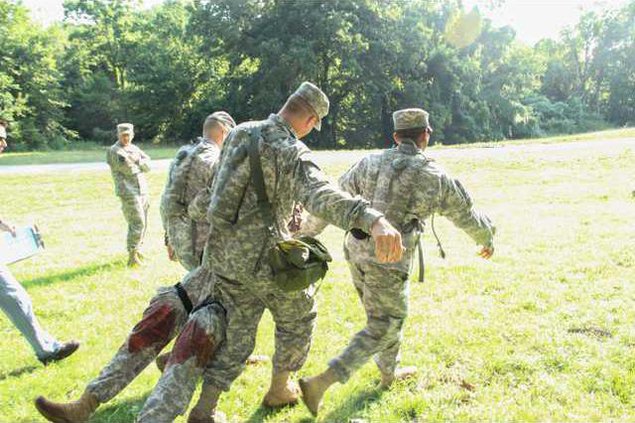Math and reading are great subjects for classroom settings, but Staff Sgt. Cory Payne said learning to save the life of a fellow soldier in the middle of a combat situation requires more than textbooks and whiteboards.
That’s why Barton Community College has made it a priority to provide hands-on scenario-based emergency medical learning opportunities to soldiers through Combat Lifesaver (CLS) training. In the high-pressure, time-constrained scenarios, soldiers are tasked with controlling bleeding, managing airways, treating penetrating chest trauma and initiating evacuation.
Soldiers at Fort Leavenworth received the week-long training from Barton in early August. The rigorous curriculum consists of 35-40 hours of didactic and practical training, from written tests and classroom work, to the in-field simulations.
“It definitely is different than any CLS class I’ve had before. The last CLS class I took was death-by-PowerPoint. It was a book, a test and a little CPR,” said Payne, who is has been a corrections officer at the Fort Leavenworth Penitentiary for seven years. “The hands-on training, getting us running around and breaking a sweat and getting us to think and adding all the chaos and whatnot was definitely different than anything else I’ve done before.”
Barton Instructor Brandon Green kept a close eye on the groups throughout the morning, keeping intently focused on the task at hand because he knows somebody’s life could hang in the balance based on the quality of his teaching.
“This training is crucial because we do treat injuries on the battlefield. For people who get shot or injured, other soldiers are the ones right there with them, so they provide the first care there – the immediate care,” Green said. “They learn to treat bleeding, airways and chest wounds. If you take care of those things in the first two minutes, the chance of survival increases dramatically.”
Other organizations have taught versions of CLS, but Green said Barton does it very well.
“As far as Barton goes,” he added, “it’s one of the better ones around.”
Barton’s Executive Director of Technical and Military Programs John Truitt said the course has been offered at Fort Leavenworth for about six years.
“Combat Lifesaver is one of many types of technical training Barton provides to the Military Community. Through its Military On-site Training (MOST) program, Barton’s flexibility of offerings and quality of instruction sets it apart from similar organizations. Training can be conducted at the Military Unit’s location anywhere across the country. Curriculum and hours can be tailored to fit the needs of the organization whether it’s incorporating special equipment or teaching class during weekends, evenings, or nights,” Truitt said. “Barton’s Military Program instructors are experts in their fields who bring real world experience to the training. Their dedication to excellence and drive to make a difference is what makes our program exceptional.”
Battle Tested
BCC provides hands-on Combat Lifesaver Training at Fort Leavenworth





